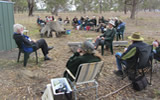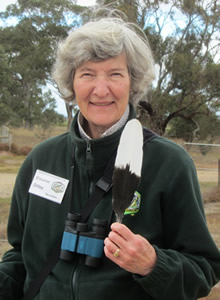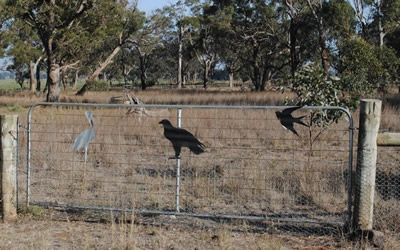 Ringwood Field Naturalists visit Pinkerton Forest
Ringwood Field Naturalists visit Pinkerton Forest
On Sunday 12th April 2015 the Ringwood branch of the Field Naturalists Club of Victoria visited Pinkerton Forest. About 35 people participated, making this one of our largest visits to Pinkerton. The Field Naturalists were most impressed with the forest and discussed the possibility of returning, perhaps in spring.
The visitors saw a total of 48 bird species; 49 if we count the New Holland Honeyeaters in a front yard at the Mt Cottrell gate. Along the lane that leads from Mt Cottrell Road to the Forest we saw several Goldfinches, Flame Robins and Willy Wagtails, Yellow-rumped Thornbills as well as several House Sparrows and a Diamond Firetail.
We also saw 4-5 Diamond Firetails beside the lane that leads to the shed. We saw several Diamond Firetails at this same spot on the last Birdlife Australia survey. There were also about 50-60 zebra Finches on the fence bordering Pinkerton Link. They were continually flying to and from the paddock, very noisily.
 There was excitement when several observers reported a female Pink Robin, identified by several observers by its brown colour. We were told that other female robin species are grey in colour: only the female Pink Robin is brown. One visitor had been studying the differences between the robin species after reading about one being seen recently in nearby Eynesbury Forest. However, there is still some lively debate among bird experts as to whether the bird is a female Pink Robin or a female Flame Robin! Consensus appears now t that it was probably a Flame Robin. A graphic example that identifying various similar looking female robin species can be sometimes difficult, especially when moving about among the foliage high in a tree!
There was excitement when several observers reported a female Pink Robin, identified by several observers by its brown colour. We were told that other female robin species are grey in colour: only the female Pink Robin is brown. One visitor had been studying the differences between the robin species after reading about one being seen recently in nearby Eynesbury Forest. However, there is still some lively debate among bird experts as to whether the bird is a female Pink Robin or a female Flame Robin! Consensus appears now t that it was probably a Flame Robin. A graphic example that identifying various similar looking female robin species can be sometimes difficult, especially when moving about among the foliage high in a tree!
Another visitor picked up a fresh looking White-bellied Sea-eagle tail feather beside the graves of the pioneering Pinkerton family. A few years ago a pair of sea-eagles nested in Pinkerton Forest for two years running. They had taken possession of the forest after an aerial battle with the resident Wedge-tailed Eagles. The Wedge-tailed Eagles have since retaken possession of the forest and successfully nested here last year, in the sea-eagles’ old nest! However, the sea-eagles are still often seen, along the Werribee River or circling over the sewerage treatment ponds looking for fish and waterbirds, and both around and over the forest, (when the wedge-tails are not present). The large feather is tangible evidence that the sea-eagles still maintain a presence here.
As we enjoyed morning tea among the trees, Bryan Campbell, a descendent of the original Pinkerton pioneering family gave a presentation about his ancestors who were the original European settlers here. He also spoke at length about his famous grandfather A J Campbell.
A J Campbell was a member of the Pinkerton family. He was an early ornithologist and one of the earliest members of the Field Naturalists Club of Victoria. His interest in birds and natural history was no doubt fuelled by many visits to Pinkerton Forest and the nearby Werribee River. He advocated the creation of ‘Wattle Day’ to commemorate these most well-known of Australian flowers; and as a celebration of Australia.
After viewing the commemorative plaque depicting the Pinkerton family and photos of the various family members, the visitors were struck by the resemblance of Bryan Campbell to his famous ornithologist grandfather A J Campbell!
 Our Restoration Co-ordinator, Frances Overmars helped to identify plants for the visitors, as some were ticking off a checklist of plants they had brought, taken from the Flora and Fauna Survey undertaken by Ecology Australia in 2007. A special find was Heath Speargrass (Austrostipa exilis). This species grows beneath Grey Box trees and is rare in Victoria. Thirty-five percent of Austrostipa species in Victoria can be found in both Pinkerton Forest and Bush’s Paddock! As the visitors mention, this is remarkable!
Our Restoration Co-ordinator, Frances Overmars helped to identify plants for the visitors, as some were ticking off a checklist of plants they had brought, taken from the Flora and Fauna Survey undertaken by Ecology Australia in 2007. A special find was Heath Speargrass (Austrostipa exilis). This species grows beneath Grey Box trees and is rare in Victoria. Thirty-five percent of Austrostipa species in Victoria can be found in both Pinkerton Forest and Bush’s Paddock! As the visitors mention, this is remarkable!
The visitors were also impressed with the bird sculptures, cut from corrugated iron, by Brian Steadman. These had been placed on the gate leading into Pinkerton Forest.
A total of 47 bird species were seen.
The Pink Robin has been reluctantly removed from the list.
White-faced Heron
Straw-necked Ibis
Black Swan
Chestnut-breasted Shelduck
Wood Duck
Grey Teal
Chestnut Teal
Black Duck
Musk Duck
Whistling Kite
Wedge-tailed Eagle
Brown Falcon
Coot
Masked Lapwing
Black-fronted Dotterel
Crested Pigeon
Galah
Sulphur-crested Cockatoo
Long-billed Corella
Little Corella
Rainbow Lorikeet
Eastern Rosella
Crimson Rosella
Welcome Swallow
Tree martin
Black-faced Cuckoo-shrike
Willy Wagtail
Grey Fantail
Flame Robin
Superb Fairy-wren
Yellow-rumped Thornbill
Brown Treecreeper
Spotted Pardalote
White-faced Honeyeater
Red Wattlebird
Noisy Miner
Magpie-lark
Magpie
Little Raven
Starling
House Sparrow
Diamond Firetail
Zebra Finch
Goldfinch
Golden-headed Cisticola
